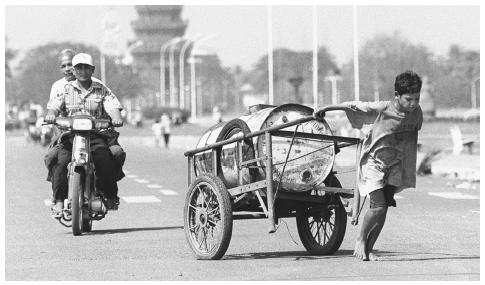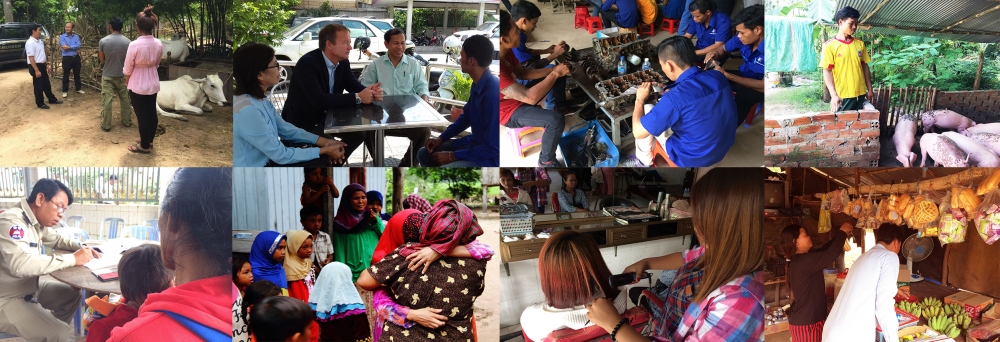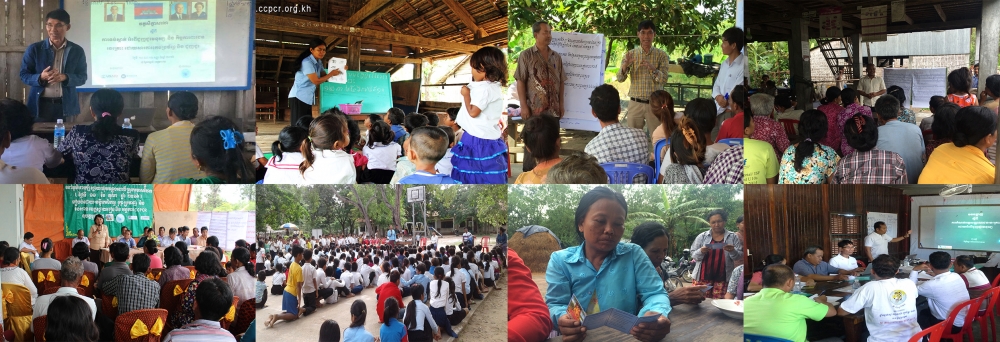Child Labor Prevention Program

CCPCR currently works in the Kampot and Kampong Thom Provinces to help combat child labor.
Background context
About 90 per cent of the poor population of Cambodia live in rural areas, and 71 per cent are employed mainly in subsistence agriculture. The vast majority of workers in the country are either self-employed or are engaged in unpaid family labour. Only 15 per cent of those aged over 15 years of age are paid workers. This poverty situation leads to child labor. The consequences and social cost of child labor for Cambodia cannot be over emphasized. The impairment to physical, mental and social health and education at the critical early stage of life has permanent effects on the quality of adult life. The overall consequence to society is even more severe. In the long run, an under-educated society cannot meet the demands for advanced skills and higher technological standards of a global economy and hence has a lower national capacity to fight poverty, perpetuating the cycle of poverty.
The elimination of child labor and, as a matter of priority, its worst forms, is therefore a key strategic measure to reduce poverty and insure economic growth.
The government has placed the following agreements in place to help eliminate child labor:
The elimination of child labor and, as a matter of priority, its worst forms, is therefore a key strategic measure to reduce poverty and insure economic growth.
The government has placed the following agreements in place to help eliminate child labor:
- Ratified the UN Convention on the Rights of the Child in1992;
- Ratified the ILO Convention No. 138(Minimum Age for Admission to Employment) in 1999;
- Ratified the ILO Convention No. 182(Worst Forms of Child Labour) in 2005;
- Implemented provisions that seek to protect the rights of children based on the 1993 Constitution;
- Set the minimum age for employment at 15 years in the Cambodian Labour Law;
- Promulgated 7 Prakas or Ministerial Orders that lay down the conditions of work in various sectors of employment, all of which have specific clauses on the employment of children.
- Adopted and approved for implementation an ASEAN Inter-Parliamentary Organisation Resolutionto prevent and eradicate the worst forms of child labour in 2004; and
- Established a Department of Child Labour, which exclusively works towards eliminating child labour.
- Tasked all the Provincial/Municipal Departments of Labour and Vocational Training to pay special attention and actively work towards eliminating child labour in coordination and collaboration with all relevant agencies.
Kampot Project
The Kampot project, “Towards the Elimination of the Child Labor in Salt productiona nd Fishing Sectors in Kampot Province of Cambodia" started in 2002. CCPCR worked on the project with ILO/IPEC and other NGOs, with the aim to achieve the following:
-
Develop workplace monitoring and structure: team members were instructed in child labor monitoring and a computer database was developed to keep track of each targeted child.
-
The child labor team conducts awareness raising workshops on child labor among employers, parents and working children.
-
With technical input from the ILO, all workplace monitors were trained on occupational health and safety and risk assessment at workplaces.
-
Children removed from hazardous working conditions have been reintegrated into formal education system, given non-formal education or attempts have been made to reduce their working hours and the work hazardous to their health.
-
The Child Labor Monitoring team regularly monitors and provides counseling to both employers and children. Help has been given to families to set up small business for new income generation so that they were able to send their children to school.
-
Children have been educated on the harms of child labor and are used as peer advocates to combat the situation.
-
Assist poor families to set up Self Help Groups and build their capacity for increasing income. Link families to financial services to obtain credit for setting up and sustaining their income generating activities.
-
Provide vocational skills for at risk children and their families such as repairing general machines, motorbikes, sewing clothes, hairdressing and raising animals.
-
A Provincial Committee on Child Labor was established to oversee the project implementation, it also plays a supporting role in discussions on child labor related policies, programs and other emerging issues facing stakeholders. A draft Prakas (Ministerial Order) on employment of young workers in Salt production was forwarded to the Sub-Committee and Child Labor and Labor Advisory Committee for their endorsement.
Kampong Thom Project
The Kampong Thom project, "Towards the Elimination of Child Labour in the Inland Fishing Sector in Kampong Thom Province" started in 2010. CCPCR is responsible for implementing the Action Program as set by ILO/IPEC.
CCPCR's main objectives are to
CCPCR's main objectives are to
-
Identify children working in the inland fishing sector in Phat Sanday Commune in Kampong Thom, and children at risk of joining such a work force in the near future and their families in the commune and villages
-
Consult with parents and schools to help at risk children to remain in school
-
Work with parents and schools to remove children currently working in the inland fishing sector in Kampong Thom and help them enroll in schools or provide opportunities for non-formal education through the Community Learning and Child Labour Rehabilitation Centers
-
Assist poor families to set up Self Help Groups and build their capacity for augmenting income and link the families to financial services to obtain credit for setting up and sustaining their income generating activities.
-
Identify Community Child Labor Monitors and train them to continuously monitor the situation in the inland fishing sector in target areas.
Activities
- Child Pursues Education, After CTIP Supports on Business to Family
- Vulnerable People sharing Experienced on Benefit of Raising Chicken
- Helping Vulnerable Families Improve their Lives
- Trafficking Survivor Sharing Experience of migration
- My Dream Came True as a Barber
- Former Trafficked Victim Got supported to Improve Livelihood
- Livelihood Supported to Pursue Hope
- âMy Dream Come True with Hair Dressing and Salon Businessâ
- Rice Bank Met the Need of People to Stop Risky Migration
- Pig Raising to Improve livelihood of Survivors
- "Cows Bank", is the Resource of Sustainable Livelihood
- We Together to End Human Trafficking
- From Miserable Life to Get a Skill of Hairdressing
- SVG Trained Beneficiary to Be Sustainable Farmer
- Local Leaders Share Lessons Learned and Plan for Sustainable Anti-Trafficking Efforts
- Successful Collaboration to Return 33 victims from Vietnam
- Survivors of Labor Trafficking Receive Support to Pursue Safe and Sustainable Income Sources
- CCPCR Conducts a Chicken and Pig Raising Training for Capacity Building
- 23 Labor Trafficking Victims Were Back to Community Successfully
- Chinese Guests Visited CCPCR to Hear Experience of working with Human Trafficking Victims
- AOI's Students Visited Child Prevention Project
- Collaborative Effort Leads to Successful Repatriation of 54 Cambodian Men Trafficked to Fishing Boats
- Risky Migrationâ Lead to Trafficking Issues
- Livelihood Training Workshop on Chicken and Pig raising to Victims and Victims'family
- 15 Survivors Returnedâ back to Community With New Life
- 4 victims of human trafficking from Vietnam, Returned Back Successfully
- Eleven Trafficked Children to Beg in Vietnam, Returned to Cambodia
- CTIP Secures the Second Chance at Education for 22 Trafficked Children Forced to Beg in Vietnam
- National Verification Process in Thailand
- Press on After Trafficking Launch
- Angkor Wat Bike4Kids! Event
- Radio Australia Broadcast
- Featured in Global South Development Magazine
- A major fundraising campaign for CCPCR!
- CCPCR's Christmas party!
- Painting in Phnom Penh!
- Sihanoukville Shelter - Can you help?
- Lotus House - Siem Reap
Download Document
- Local Leaders Share Lessons Learned and Plan for Sustainable Anti-Trafficking Efforts
- Successful Collaboration to Return 33 victims from Vietnam
- 2015 Annual Report
- Snapshot-Forum Empowers Human Trafficking Survivors to Make Recommendations to Policymakers and NGOs
- Snapshot-Survivors of Labor Trafficking Receive Support to Pursue Safe and Sustainable Income Source
- CCPCRâs Prevention Activities for October
- CCPCR CSO Certificate certified and approved by Minister of Ministry of Social Affair
- Case study - IOM training on representatives of 14 child clubs
- 2014 Annual Report
- Case study - Child Club in Thmei commune
- Case Study - Teng Mao Community
- Case Study - Training on pig farming in Thnout commune
- Case Study - Community Learning Centre in Chres commune
- Case Study - Parental Group in Tuol Ampal village
- Case Study - Child Club in Kandal Village in Thnout
- More than just victims- the truth about human-trafficking
- What are you grateful for?
- Shelter Appeal
- CCPCR's Rehabilitation strategy
- Organizational Chart
- CCPCR's Child Protection Policy
- Human-trafficking in Cambodia
- Human Trafficking FAQ's
- Statement for human rights day, December 10, 2014.
- Current situation on process to migrate to Thailand in EN
- Current situation on process to migrate to Thailand in Kh
- 2013 Annual Report
- 2012 Annual Report
- Svay Rieng Shelter
- 2011 Annual Report
- 2010 Annual Report
- Svay Rieng Presentation 2010
- CCPCR's Rehabilitation strategy



